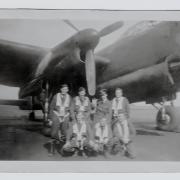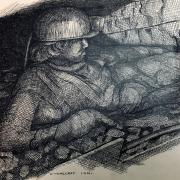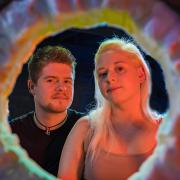‘The Past is a different country, they do things differently there,’ said L.P.Hartley, but delve into Cheshire’s past and you’ll find that love never changes

The city
Chester is full of romantic places. It’s said that if you run up The Wishing Steps, without drawing breath, you will meet your future spouse. If this happened to an Edwardian lady, she might persuade her beau to accompany her to Bonewaldesthorne Tower: a popular place for Edwardian swains to pop the question, as was Lovers’ Walk at Newton Hollow.
A Victorian lady had a lucky escape when she was almost caught canoodling with a married lover in his office in Abbey Gate. Preferring death to disgrace, she jumped out of the window but, luckily for her, or maybe not, her voluminous crinoline ballooned and she floated safely down!
Five centuries ago, the Mayor of Chester’s daughter, Ellen, fell in love with Luke, a penniless suitor. The Mayor, William Aldersey, was determined that she would marry a rich man and forbade the lovers to meet. He kept a close eye on her, allowing her to leave the house only if she was accompanied by other ladies. One day, she gave them the slip by pretending to retrieve a ball she had thrown but instead rushed to meet her lover, escaping with him through The Peppergate, not stopping until they had reached Wales.
Her incensed father ordered that The Peppergate be closed for evermore. Legend says the lovers made their fortune and returned to Chester, where they were reconciled.

The archives
Within The Cheshire Record Office are the stories of many local love affairs. One couple were in a hurry to get married in 1780: understandably maybe as the bride, Martha Cheetham was 83 and the groom, Daniel Broadbent, 23. Instead of waiting for the traditional banns, they gained a licence allowing them to marry on the same day, with the proviso that if the marriage was found to be unlawful, the equivalent of £15,000 would be forfeited. It wasn’t and the pair embarked on their marriage which ended a year later with the death, not of Martha as might be reasonably expected, but of Daniel.
The Rumneys weren’t in such a rush and the Record Office holds their letters which, in typical romantic fashion, were discovered, carefully stored, in an old chest which had been sent for auction. Written between 1886-7, they show the growing love between Jessie Rowland, 16, of Grimsditch Hall, Lower Whitley and her cousin Charles Rumney, 27. Jessie begins by calling him, ‘Dear Charlie’ but a year later, he is ‘My Dearest Charlie’ and she is expressing amazement that he could love her and signing her letters with, ’hundreds of kisses.’ Her only complaint is an old one: his letters could be longer!
They married at Lower Whitley Church in 1888 and lived at Grimsditch Hall, with their three children: the last surviving one, Kathleen Joyce, died there in 2004.

www.archives.gov.cheshire.uk/
The stately home
Gawsworth Hall in Macclesfield is a hugely romantic location and, at its heart, is a beautiful woman who has intrigued generations.
Mary Fitton, possessed of a most remarkable beauty, was born here in 1578. Many believe that she was the Dark Lady to whom Shakespeare dedicated his sonnets, maybe even breaking his heart.

Mary certainly had a taste for love affairs which might explain some of Shakespeare’s laments about his lover’s infidelity! She became a Maid of Honour to Elizabeth 1 but, as a result of an affair with the Earl of Pembroke, she fell pregnant and was sent home in disgrace.
This shocked her family who had entertained high hopes that the Queen would visit them and had spent huge amounts of money, all now in vain, to ready the Hall for the honour, but Mary continued to be swayed by love, having at least another two affairs. Her mother was enraged, felt ashamed and asked her other daughter not to mention her any more. Mary eventually married a Pembrokeshire man named Lougher and lived until she was 69.
The art gallery
India has the Taj Mahal but Cheshire has the Lady Lever Art Gallery in Port Sunlight, also built in memory of an adored wife. Lord Lever had known Elizabeth, the love of his life, since he was a young man but wanted to be financially secure before they finally married in 1874.

He became famous for his industrial and philanthropic work but, when Elizabeth died in 1913, he vowed to build a memorial that would reflect the elegance and grace for which she had been known. The result was the Lady Lever Art Gallery which, appropriately, holds some very romantic pieces of art.
At its opening by Princess Beatrice in 1922, Lord Lever paid tribute to Elizabeth by saying: ‘The greatest inspiration to me has been the wife I was fortunate to win.’
He died in 1925 and their magnificent tombs, complete with effigies, lie side by side in Christ Church, Port Sunlight.
The museum
The Grosvenor has many romantic objects, including wedding dresses and wedding rings. One 14th century ring was discovered, hidden with some coins, and is decorated with flowers and a heart. Made of silver, it was obviously a treasured possession but whoever hid it, never saw it again. Less expensive but equally treasured later items are handmade Valentine cards. They date from the late 18th century, are usually intricate and romantic and always anonymous. It’s fun to imagine the romantic fate of the senders as well as being inspired to make your own.



























